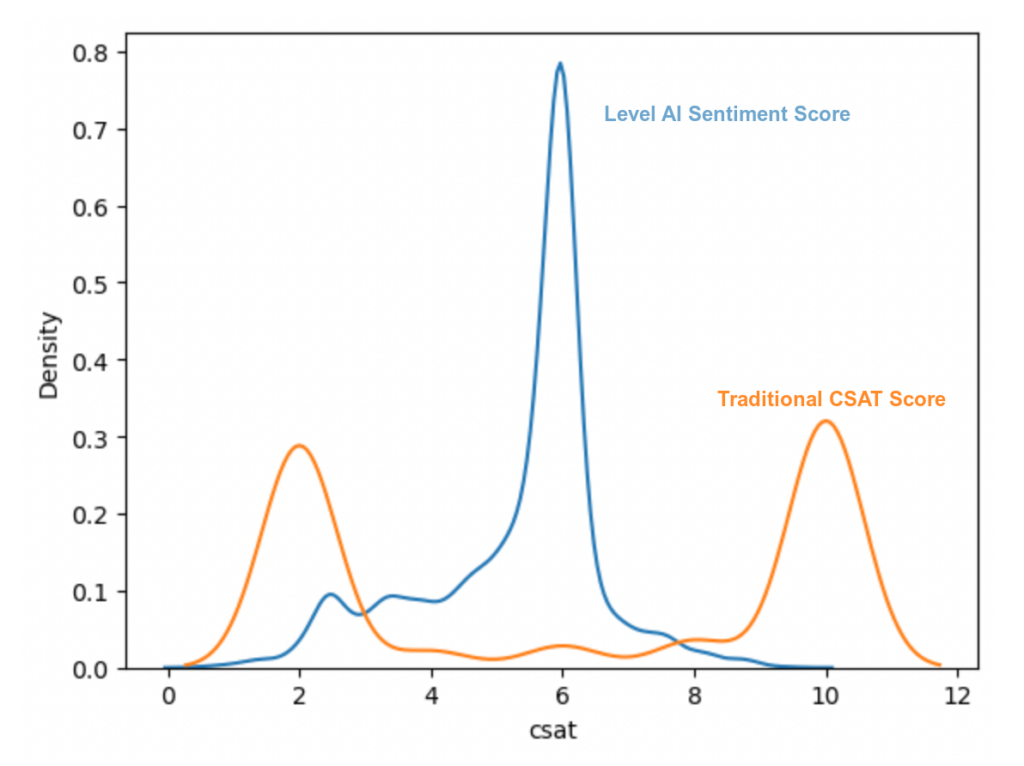Level AI’s Sentiment, Customer Effort, and QA Insta-Scoring: A Comprehensive Insight into Conversations


In today's intricate realm of customer service and engagement, businesses are on the constant prowl for techniques that deliver a clear understanding of customer satisfaction. Traditional tools like the Customer Satisfaction (CSAT) score were once the mainstay. However, as interactions grow more complex and businesses lean towards data-driven insights, the limitations of CSAT become glaringly evident. Addressing this need, Level AI brings forward the trio of Sentiment Score, QA InstaScore, and the revolutionary Customer Effort Score (CES). These tools collectively offer an exhaustive 360-degree panorama of customer interactions, going beyond the surface to delve deep into the core of conversations.
The Three Scores: A Quick Proxy for Conversation Insights
- Sentiment Scoring: An advanced tool to gauge the depth and breadth of customer emotions by analyzing the entirety of conversations rather than isolated keywords.
- Customer Effort Score (CES): A metric that quantifies the effort a customer expends during an interaction, highlighting the ease or friction they experience.
- QA-GPT InstaScore: This tool is designed to scrutinize the operational aspects of conversations, focusing on agent compliance, behavior, and overall adherence to business-specific criteria.
The Shortcomings of CSAT & Legacy Sentiment Analysis
CSAT has been a mainstay in the industry for gauging customer satisfaction, typically prompting customers with a question like "How satisfied were you with your experience?". However, CSAT comes with inherent limitations:
- Polarized Feedback: Often, the feedback collected through CSAT methods results in a "dwell" or "inverse bell" curve. This means businesses mostly hear from either very satisfied or very dissatisfied customers, with little to no feedback from the vast middle ground.
- Misleading Scores: CSAT can sometimes be deceiving. For instance, a customer might award a high CSAT score simply because their long-standing issue was finally resolved, even if the resolution process was protracted and convoluted.
- Contextual Understanding Over Keywords: Existing tools detect sentiment based on a handful of buzzwords. Our approach prioritizes the overarching context. A statement like "Why am I being charged for a service I never received?" is identified as expressing disappointment, despite the absence of direct keywords. A single number or keyword can't capture the intricate dynamics of a customer's emotions or the evolving sentiment throughout a conversation, but by focusing on the larger context, we ensure a more accurate representation of the customer's feelings.
- Deep-Dive Insights Over Broad Classification: While CSAT scores give a broad classification of customer experience, they often miss the “why” behind a good or bad experience. By integrating sentiment scoring with Voice of the Customer (VOC) feedback, we provide insights on a much larger scale with detailed context. For instance, a sentiment score of 4/10 coupled with the concern "unable to get a refund" offers a clearer picture, revealing that the customer had an unsatisfactory experience specifically related to refund issues. This combination of sentiment score and VOC allows businesses to delve deeper into customer feedback and understand the root causes of sentiments.
How Level AI's Sentiment Scoring Revolutionizes Customer Feedback
Level AI's Sentiment Scoring goes beyond the limitations of CSAT, offering businesses a comprehensive understanding of their customer’s experience in interactions. Here's why our Sentiment Scoring stands out:
- Deep Analysis: Unlike CSAT, which tends to capture polarized views, our sentiment scoring reviews every conversation. This inclusive approach ensures no sentiment, whether strong or moderate, is overlooked.
- Dynamic Evolution: Sentiment isn’t a static entity. With our sophisticated timing weightage, we chart the ebb and flow of emotions during interactions. This means businesses can now pinpoint phases where sentiment shifts, gaining insights into potential triggers.
- Eliminating Length Bias: Our AI model adjusts sentiment scores based on conversation length. Whether it's a quick query or a lengthy discussion, each interaction is assessed with equal weightage, ensuring accurate sentiment representation.
- Granularity at its Best: We believe in the spectrum of emotions. Our scoring isn’t confined to binary classifications; instead, it spans from mildly positive to strongly negative sentiments. This granularity helps businesses dissect feedback and generate actionable insights.

Level AI's Customer Effort Score (CES)
In the contemporary world of customer service, just understanding customer sentiment isn't enough. Businesses need to discern how much effort customers have to exert to get their issues resolved or questions answered. Level AI's CES comes into play precisely here, bridging this information gap and offering valuable insights.
The Philosophy Behind CES
CES is grounded in a simple idea: The easier it is for customers to interact with a service, the more loyal they are likely to become. Instead of merely asking whether customers are happy or not, CES probes into how seamless their experience was, which has a direct bearing on loyalty, repeat business, and advocacy.
How CES is Computed
Level AI’s CES system is meticulously designed, examining customer effort through three pivotal factors measured by several indicators:
1. Indicators of Difficulties Faced by Customers:
- Customer Frustration: A metric to evaluate if customers displayed evident frustration during their interaction. High levels of frustration can significantly amplify the effort score.
- Customer Sentiment: It's not just about strong negative emotions; the overall sentiment shade during the conversation impacts the CES.
- Call Transfer: Research, including notable findings from Gartner, has shown that call transfers can dramatically heighten the effort for customers. Recognizing a transfer is critical for CES evaluation.
- Supervisor Escalation: When customers escalate issues, it's a clear indication of increased effort and dissatisfaction with the service.
- Customer Repetition: Repeatedly explaining the same problem can be exhausting for customers. The more a customer has to repeat, the more effortful the experience.
2. Measures of Time Spent in Conversations:
- Relative Call Duration: Comparing the duration of a specific conversation to the average call duration for that topic and channel can reveal if the customer had to spend an unusually long time.
- Hold Time Proportions: A high hold time relative to the total conversation duration can be a strong indicator of increased customer effort.
3. QA GPT-Based Evaluators for Business Criteria:
- Proactive Agent Efforts: Recognizing agents' proactive steps to alleviate customer effort can shed light on the overall experience's ease.
- Agent's Product Knowledge: Quick resolutions backed by solid product knowledge reduce customer effort.
- Agent Uncertainty: If agents express uncertainty, it can make the experience more laborious for the customer.
- Offer of Further Assistance: When agents offer further help at the conversation's conclusion, it can ease customers' journey.
- Agent Empathy: Proper empathetic responses can significantly reduce the perceived effort for customers.
- Connection Issues: Any disruptions or connection problems can complicate the conversation, adding to customer effort.
The Grading System Based on the accumulated data from these factors, each interaction gets a CES grade on a scale:
- 1-3: Very Low Effort
- 3-5: Low Effort
- 5-6: Neutral
- 6-8: High Effort
- 8-10: Very High Effort
Incorporating CES into the evaluation matrix offers businesses the opportunity to rectify pain points in the customer journey. By reducing effort, businesses can enhance customer loyalty, leading to higher lifetime values and positive word-of-mouth referrals. In essence, a low CES can be a direct pathway to sustained growth and profitability.
Level AI’s AutoQA InstaScore: Complementing Sentiment Scoring and CES
While Sentiment Scoring provides a view into the customer's emotional journey, InstaScore gives insights into the operational side of the conversation, ensuring that businesses have a holistic understanding of agent adherence to procedures.
- Purpose-built for your business: InstaScore, with its proprietary GPT Model, is tailored to a company’s specific business requirements, ensuring that every insight is contextually relevant.
- Ensuring Compliance: Customer interactions aren't just about resolving issues; they need to be compliant. InstaScore ensures agents uphold necessary guidelines and processes, guaranteeing each interaction is in line with regulatory standards.
- Behavioral Analysis: More than just transactions, InstaScore assesses an agent's empathy and professionalism, offering insights into the human side of interactions.
- Evidence-Based Scoring: InstaScore isn’t just about giving a score. It’s about explaining why a score was given, underpinned by direct conversation quotes. This transparency fosters accountability and continual improvement.
Conclusion
The age-old CSAT, while useful, falls short in today's intricate customer interaction landscape. Level AI’s suite, comprising Sentiment Scoring, InstaScore, and CES, bridges this gap. Equipping businesses with tools that provide both a macro and micro understanding, it paves the way for optimized customer interactions and business growth.
Keep reading
View all





